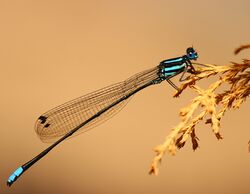Biology:Esme cyaneovittata
| Esme cyaneovittata | |
|---|---|

| |
| Male | |
| Scientific classification | |
| Domain: | Eukaryota |
| Kingdom: | Animalia |
| Phylum: | Arthropoda |
| Class: | Insecta |
| Order: | Odonata |
| Suborder: | Zygoptera |
| Family: | Platycnemididae |
| Subfamily: | Disparoneurinae |
| Genus: | Esme |
| Species: | E. cyaneovittata
|
| Binomial name | |
| Esme cyaneovittata Fraser, 1922
| |
Esme cyaneovittata[2][1] is damselfly in the family Platycnemididae. It is endemic to Western Ghats in India , south of Palakkad Gap.[1][3]
Description and habitat
It is a medium-sized damselfly with black-capped blue eyes. Its thorax is velvet-black on dorsum and azure blue on sides. The dorsum is marked with narrow ante-humeral blue stripes. There is another moderately broad black stripe over the postero-lateral suture. The base of the sides is pale blue. Wings are transparent with black pterostigma. Abdomen is black, marked with azure blue on segment 1 and 2. Segments 3 to 7 have very narrow baso-dorsal annules. Segments 8 to 10 are blue. The apical border of 10 and the ventral borders of all segments are broadly black. Anal appendages are black. Female is similar to the male; but more robustly build.[4]
It can be distinguished from Esme mudiensis from its labrum marked with blue. From Esme longistyla, it can be distinguished by its black legs unmarked with blue, by its stout inferior anal appendages, and by the broken blue lateral stripe on the thorax.[4]
It is found along hill streams, commonly found in colonies like those of Caconeura gomphoides.[4][5][6][7]
See also
- List of odonates of India
- List of odonata of Kerala
References
- ↑ 1.0 1.1 1.2 Kakkasery, F. (2011). "Esme cyaneovittata". IUCN Red List of Threatened Species 2011: e.T175196A7120490. doi:10.2305/IUCN.UK.2011-1.RLTS.T175196A7120490.en. https://www.iucnredlist.org/species/175196/7120490. Retrieved 20 November 2021.
- ↑ "World Odonata List". University of Puget Sound. https://www.pugetsound.edu/academics/academic-resources/slater-museum/biodiversity-resources/dragonflies/world-odonata-list2/.
- ↑ K.A., Subramanian; K.G., Emiliyamma; R., Babu; C., Radhakrishnan; S.S., Talmale (2018). Atlas of Odonata (Insecta) of the Western Ghats, India. Zoological Survey of India. pp. 112–113. ISBN 9788181714954.
- ↑ 4.0 4.1 4.2 C FC Lt. Fraser (1933). The Fauna of British India, including Ceylon and Burma, Odonata Vol. I. Red Lion Court, Fleet Street, London: Taylor and Francis. pp. 263-264. https://archive.org/details/FraserOdonata1.
- ↑ C FC Lt. Fraser (1924). A Survey of the Odonate (Dragonfly) Fauna of Western India with Special Remarks on the Genera Macromia and Idionyx and Descriptions of Thirty New Species. Zoological Survey of India. Volumes (Records). pp. 506. http://faunaofindia.nic.in/PDFVolumes/records/026/05/0423-0522.pdf.
- ↑ Subramanian, K. A. (2005). Dragonflies and Damselflies of Peninsular India - A Field Guide. http://www.ias.ac.in/Publications/Overview/Dragonflies.
- ↑ "Esme cyaneovittata Fraser, 1922". India Biodiversity Portal. http://indiabiodiversity.org/species/show/227132.
External links
Wikidata ☰ Q2386195 entry
 |


